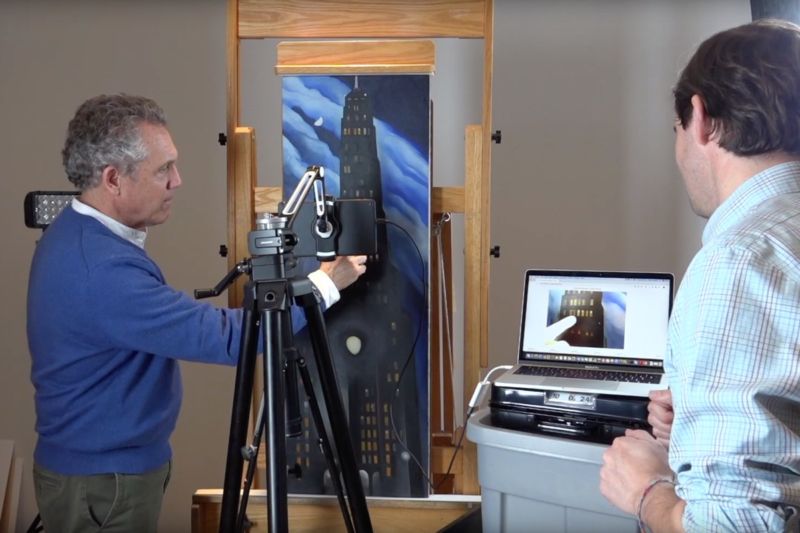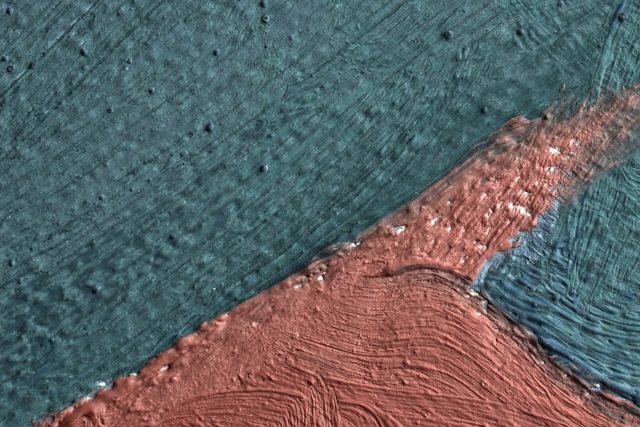
The Georgia O'Keeffe Museum in Santa Fe, New Mexico, houses some 140 oil paintings by the iconic American artist, along with thousands of additional works from O'Keeffe's prolific career. But the oil paintings have been developing tiny pin-sized blisters, almost like acne, for decades. Conservationists and scholars initially assumed they were grains of sand trapped in the paint. But then the protrusions grew, spread, and started flaking off, leading to mounting concern.
Now an interdisciplinary team of scientists from Northwestern University is studying this mysterious "paint disease," using a low-cost, portable tool that allows the scientists to image the surface of the paintings quickly and easily with a smartphone or a tablet. They demonstrated the new technique last week at the American Association for the Advancement of Science conference in Washington, DC.
This "paint disease" isn't limited to O'Keeffe's oeuvre. Conservators have found similar deterioration in oil-based masterpieces across all time periods, including works by Rembrandt. Chemists concluded that the blisters are actually metal carboxylate soaps, the result of a chemical reaction between metal ions in the lead and zinc pigments and fatty acids in the binding medium used in the paint. The soaps start to clump together to form the blisters and migrate through the paint film. "They can form exudates on the surface, which obscure the painting itself, creating an insoluble film, or an effect of transparency, so you can look through those layers, which was not the intention of the artist," said Marc Walton of Northwestern University, who co-led the study.
Some 70 percent of all oil paintings have deterioration associated with metal soaps.
In fact, some 70 percent of all oil paintings have deterioration associated with metal carboxylate soaps to varying degrees, according to Walton. "Often it's benign, and nothing will happen in terms of deterioration of the paint, but in some cases it's quite destructive," he said. That's the case with O'Keeffe's work, where determining the rate of deterioration is of paramount importance.
Walton is co-director of Northwestern's Center for the Scientific Studies in the Arts (CSSA), dedicated to working with cultural institutions to offer scientific assistance as needed to solve these kinds of problems. His Northwestern colleague, Oliver Cossairt, almost attended the Art Institute of Chicago before switching to computer vision and computational imaging, so he was the perfect choice to collaborate with Walton on figuring out an easy, affordable means of documenting how the protrusions develop over time.
The two men met Dale Kronkright, head of conservation at the O'Keeffe Museum, while working with the Art Institute of Chicago. They were working on imaging the surface shape of the institute's collection of Paul Gauguin prints several years ago. Kronkright told them about the unusual protrusions he'd noticed on many of O'Keeffe's paintings while conducting a survey of the museum's collection. Some paintings have more pronounced protrusions than others, but even when the conservators restored the most damaged canvases, the pimpling returned.

"We've been working on this idea of applying 3D surface measurement [techniques] to paintings as an analysis tool for a while," said Cossairt. "We think it's possible to develop measurement tools using devices that are readily accessible to museum conservators, to get that little bit more information a conservator would need to make more informed decisions."
It's based on a technique called reflectance transformation imaging, which usually involves a lot of large, bulky equipment, including a dome containing several light sources. Most museums don't have the financial resources to buy and maintain such equipment, so Cossairt devised a more user-friendly option.
"We want to implement these 3D measurement systems as cheaply as possible and put them in the hands of as many people as possible," he said. His method uses the LED flash or LCD display of a smart phone or a tablet as a convenient light source. That source would reflect light off the surface of the canvas and capture those reflections with the front-facing camera.
The idea is elegantly simple and intuitive, similar to looking at a skyscraper with reflective windows that act as mirrors. "You see the reflection of another skyscraper or some other structure, and you notice that the lines are bent when they should be straight," said Cossairt. So the window's surface must be curved rather than flat, and that lets you determine the 3D shape of the window.
A similar principle is at work with Cossairt's imaging tool. If a painting's surface is completely flat, you would get an exact reflection of the patterns on the canvas. If there's pimpling causing unevenness, "the pattern locally distorts and stretches and shrinks in different areas," he said.
Ultimately, Cossairt hopes to build the equivalent of a handheld Star Trek "Tricorder" for museum conservationists. It would allow them to take out a smart phone, wave it in front of a canvas, and software would automatically do the analysis as the screen moves across the object, stitching together the field of view. Subsequent images can be compared to earlier ones to get a sense of what has changed since the last measurement.

Another Northwestern colleague, Aggelos Katsaggelos, is developing those software tools. "The technology uses machine learning to distinguish whether texture is a soap protrusion or something benign like a brush stroke," said Katsaggelos. "Then, for protrusions, we extract statistics: the density, size, and shape."
Cossairt's "Tricorder" tool will never replace a synchrotron, which will always be a higher-power, higher-resolution instrument for this kind of imagining. It's already commonly used to non-destructively analyze works of art and archaeological artifacts. For instance, scientists used synchrotron radiation to reconstruct the portrait of a peasant woman painted by Vincent van Gogh that the artist had then painted over when he created 1887's Patch of Grass.
However, you can't take every single piece away from a collection and bring it to a synchrotron, and access to such facilities is limited, since synchrotrons are useful for many different applications and are in high demand among scientists. So Cossairt's tool is a useful complementary method.
The next step to devising a solution for conservators is to better understand what specific factors contribute to the pimpling, including environmental factors like humidity, temperature, and exposure to direct sunlight. Walton's team is now experimenting with surrogate paintings in the laboratory, creating their own metal-soap reactions and documenting the process. Kronkright provided tons of information about the travel and exhibition history for the collection, since paintings that have traveled to public exhibitions the most seem to have more and larger protrusions.
reader comments
36